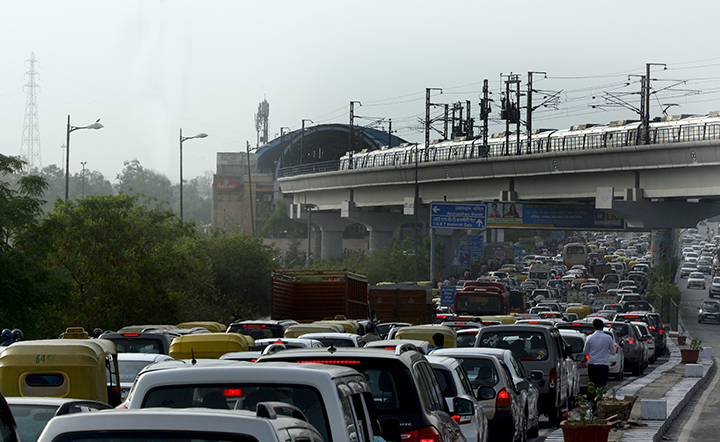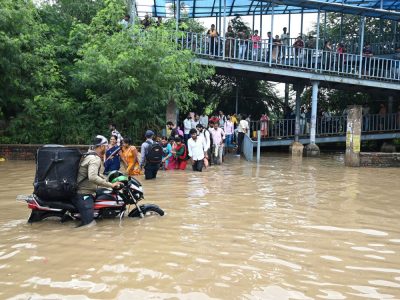If Metro allows only 50 passengers per coach, the ride may become more pleasant. But the risk of infection may push Delhi commuters to prefer their own vehicles, whether it is two-wheelers, three-wheelers or second-hand cars
What is the everyday commute for Delhi’s workforce going to look like after lockdown is completely lifted? This conundrum has been dominating conversations among Delhi’s office-goers. It would be nightmarish if one again finds oneself squished between fellow humans during peak hours on public transport.
Before Coronavirus took over everyone’s lives, peak hour on the Metro meant zero personal space, where you squeeze in between people gasping for a little cold air from the overburdened air conditioner or jostle for five inches more of standing room. Actually, it didn’t matter, as the Metro was a lifeline for office-goers. With proper distancing, the ride may just be more pleasant now.
However, the risk of infection may still be high, if one goes by what the World Health Organisation (WHO) says. Covid-19, as we all know by now, spreads through droplets of an infected person in a one-metre radius. WHO says these droplets can remain in the air for long periods of time and be transmitted to others over distances greater than one metre. This airborne transmission means that mere social distancing from a person you can physically see is not enough. If an infected person has passed that way earlier, you can still be infected.
So if the trains start running, the heavenly cool of Metro amidst Delhi’s heatwave may not be a Godsent for all, as long as the threat of virus looms. Many may avoid travelling on the Metro for non-essential trips.
On its part, the Delhi Metro Rail Corporation (DMRC) released photos on Twitter about how commuters will be expected to maintain social distancing. Every second seat on the Metro will remain vacant and those standing will maintain a metre’s distance from each other.
But then, would that then mean crowded platforms? A report quoted DMRC as saying that the revised guidelines would allow only 50 passengers in a Metro coach, which would mean its longest train of eight coaches would now have just about 400 passengers.
The DMRC website says in the pre-pandemic days, it conducted 2,700 trips per day carrying 1.5 million passengers, who travelled a distance of 17 km each. Post-lockdown, the number would substantially reduce, as people may choose other modes of transport.
Sanjay Gupta, Professor and Head of Transport Planning, School of Planning and Architecture, believes that the city will see an increase of private vehicle usage for some time. This would mean greater use of two-wheelers and second-hand cars, whose market would receive a boost.
“Government should sense this as an opportunity to come up with some sort of a sustainable mobility policy and slowly wean people off cars. The car industry has a lot of inventory so they may offer discounts to make people buy. Maybe commuters will use it in a shared mode. Whether people want that stress if traffic returns, will be seen. The bus service must improve, which will then see a good future. Metro is a preferred mode and it will continue to be used.”
With eased restrictions, Delhi Chief Minister Arvind Kejriwal has allowed auto-rickshaws, e-rickshaws and cycle rickshaws with one passenger in every vehicle to resume operations.
Buses have been allowed to take a maximum of 20 passengers in each vehicle, with all passengers being screened before boarding. Cars on the roads are allowed three passengers including the driver; this applies to cab aggregators like Ola and Uber. Pillion-riding is not allowed in case of two-wheelers, and carpooling/shared services are prohibited.
But already Delhi is seeing huge traffic jams, not just on roads connecting Delhi-Noida and Delhi-Gurgaon but in areas like ITO and Yamuna Bridge.
Before the pandemic became an all-consuming matter, the capital city’s roads were known for its traffic snarls and it seems like the break the city dwellers had from the auto emissions will soon come to pass.
Anumita Roychowdhury the Executive Director-research and advocacy and Head of Air Pollution, Mobility, Sustainable Urbanisation programmes at Centre for Science and Environment says that Metro ridership will decline by 37% from pre-Covid travel, once the lockdown is removed and Metro again is on the move. She was speaking at a webinar conducted by CSE on Reinventing Public Transport and Mobility in the ‘New Normal’.
While she is also of the view that Metro ridership would slowly come back to normalcy, their survey found that the middle- and high-income group are working out their travel options including ownership of vehicles, as health is the topmost priority.
For buses, the answer would be increasing the kilometres run by a bus, so that the government does not have to acquire more, Roychowdhaury says, “in an already stressed system”. Professor Gupta emphasises on the same: “Give more priority to buses…like during the Commonwealth Games, stringent traffic management was there for buses. If that kind of priority is given, then the same fleet of buses could increase their capacity.”
In the immediate future, though, the experts believe a rise in private vehicle usage is around the corner. SIAM released the Auto Industry Sales Performance data for March 2020 and April 2019. March had a big slump in numbers, the month in which the country was put under complete lockdown from the 25th. The production of vehicles was a total of over 14 lakh vehicles (1,447,345), including passenger, commercial, three-wheelers, two-wheelers and quadricycle in March 2020, as against a total of over 21 lakh (2,180,203) in March 2019 which meant a de-growth of (-) 33.61%.
Specifically for March, sale of passenger vehicles was 1,43,014 units compared to 291,861 units in March 2019 marking a decrease by (-) 51%, a huge slump. It picked up in the month of April with its figures accounting for April-March shows a slump of (-)17.82% with sale of 2,775,679 units in April-March 2020, compared to 3,377,389 units in April-March 2019.
Things are picking up, and in coming months a clearer picture will emerge. Professor Gupta says for the public transport to go back to normal would take about two years, while normalcy will start getting reflected by the end of the year. Till then, we may see huge traffic jams where at least one would be bumper to bumper and not shoulder to shoulder – but even this comes with its toll on our environment, our fuel consumption –, and in the end, our lungs. Making us victims of both the problem and the apparent solution.
(Cover Image: With Delhi Metro limiting the number of passengers onboard, traffic jams like this could be an all-day affair // PHOTO:GETTY IMAGES)





